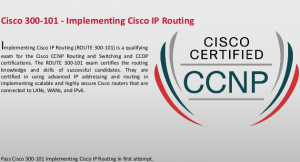Vendor: Cisco
Exam Code: 300-101
Exam Name: Implementing Cisco IP Routing (ROUTE v2.0)
Version: Demo

QUESTION 1
Prior to enabling PPPoE in a virtual private dialup 300-101 network group, which task must be completed?
A. Disable CDP on the interface.
B. Execute the vpdn enable command.
C. Execute the no switchport command.
D. Enable QoS FIFO for PPPoE support.
Correct Answer: B Explanation
Explanation:
Enabling PPPoE in a VPDN Group
Perform this task to enable https://www.leads4pass.com/300-101.html dumps PPPoE in a virtual private dial-up network (VPDN) group.
Restrictions
This task applies only to releases prior to Cisco IOS Release 12.2(13)T.
SUMMARY STEPS
1.enable
2.configure terminal
3.vpdn enable
4.vpdn-group name
5.request-dialin
6.protocol pppoe DETAILED STEPS Command or Action Purpose Step 1 enable Enables privileged EXEC mode. Example: · Enter your password if Router> enable prompted. Step 2 configure 300-101 terminal Enters global configuration mode. Example: Router# configure terminal Step 3 vpdn enable Enables virtual private dialup Example: networking. Router(config)# vpdn enable Step 4 vpdn-group name Associates a VPDN group with a Example: customer or VPDN profile. Router(config)# vpdn-group group1 Step 5 request-dialin Creates a request-dialin VPDN Example: subgroup. Router(config-vpdn)# request-dialin Step 6 protocol pppoe Enables the VPDN 300-101 exam subgroup to Example: establish PPPoE Router(config-vpdn-req-in)# pro tocol pppoe
QUESTION 2
A network engineer has been asked to ensure 300-101 that the PPPoE connection is established and authenticated using an encrypted password. Which technology, in combination with PPPoE, can be used for authentication in this manner?
A. PAP
B. dot1x
C. IPsec
D. CHAP
E. ESP
Correct Answer: D Explanation
Explanation: With PPPoE, the two authentication options are PAP and CHAP. When CHAP is enabled on an interface and a remote device attempts to connect to it, the access server sends a CHAP packet to https://www.leads4pass.com/300-101.html dumps the remote device. The CHAP packet requests or “challenges” the remote device to respond. The challenge packet consists of an ID, a random number, and the host name of the local router.
When the remote device receives the challenge packet, it concatenates the ID, the remote device’s password, and the random number, and then encrypts all of it using the remote device’s password. The remote device sends the results 300-101 back to the access server, along with the name associated with the password used in the encryption process. When the access server receives the response, it uses the name it received to retrieve a password stored in its user database.
The retrieved password should be the same password the remote device used in its encryption process. The access server then encrypts the concatenated information with the newly retrieved password–if the result matches the result sent in the response packet, authentication succeeds. The benefit of using CHAP authentication is that the remote device’s password is never transmitted in clear text (encrypted). This prevents other devices from stealing it and gaining illegal access to the ISP’s network.
Reference: http://www.cisco.com/c/en/us/training-events/training-certifications/exams/current-list/route2.html
Read more: https://www.examsdemo.com/best-study-guide/